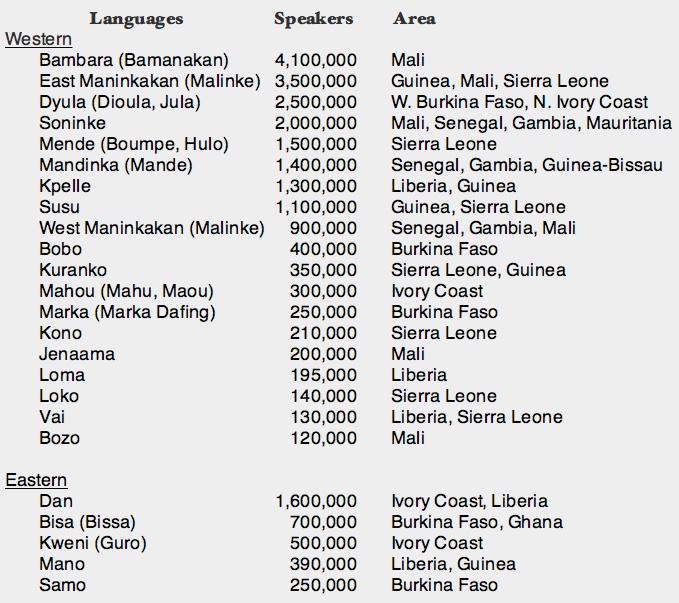An insatiable appetite for ancient and modern tongues


Overview and Distribution. Mande is a linguistic family, of disputed affiliation, comprising some 40 languages spoken by about 25 million people in the west coast of Africa. They are concentrated, above all, in southern and eastern Guinea, and southwestern Mali. There are also Mande speakers in adjacent regions of western Ivory Coast, western Liberia, eastern Sierra Leone, southern Senegal, Gambia, Guinea-Bissau, and southern Mauritania. Isolated pockets are found in western Burkina Faso, in the northern regions of Ghana, Togo and Benin, in southwestern Niger and northwestern Nigeria.
External Classification: Mande is thought to belong to the Niger-Congo phylum. However, its affiliation to Niger-Congo is disputed and some authors think that it is an independent family. If it does belong to Niger-Congo, it must have separated early from the ancestor language as it doesn't share with the rest of the family the noun-class system.
Internal Classification and Speakers. Mande languages are spoken by around 25 million people. They are divided into a western and an eastern group which have 27 and 13 languages, respectively. The most important of them are:

SHARED FEATURES
-
✦ Phonology
-
-Most Mande languages have a seven vowel system (i, e, ɛ, a, u, o, ɔ), though it varies from five to nine in different languages. Many of them have contrastive nasal vowels.
-
-The consonant inventory includes, usually, pairs of voiceless-voiced stops and fricatives. The stops are articulated at four points; labial (p-b), dental (t-d), velar (k-g) and, remarkably, labio-velar (kp-gb). The fricatives are labial (f-v) and dental (s-z).
-
-Western Mande words are frequently disyllabic with a CVCV (consonant-vowel-consonant-vowel) sequence. In contrast, most Eastern Mande languages are monosyllabic with a CV, CLiquidV, or CVV structure.
-
-Mande languages are tonal. Tones affect morphemes or entire words rather than individual syllables. The majority have two tones but up to five are found (e.g., in Dan). In Mande, tones serve to make lexical and grammatical distinctions.
-
✦ Morphology
-
-Exceptionally among Niger-Congo, Mande languages do not have a noun class system.
-
-Mande verbs are not inflected for subject. Tense and aspect are marked with verb suffixes or in some languages with a 'predicative marker' placed between subject and object. The 'predicative marker' reflects the person and number of the subject.
-
-There are no serial verbs.
-
✦ Syntax
-
-Sentence word order is Subject-Object-Verb. Nouns are preceded by possessive pronouns and followed by articles, demonstratives and adjectives. Postpositions are used.
-
-Mande languages distinguish between inalienable and alienable possession; in the first one, possession is indicated by mere juxtaposition, in the second one by a genitive marker or possessive affixes.
-
✦ Writing
-
-Indigenous writing systems were developed for some Mande languages, from the 19th century onwards. Most of them were syllabic, like Vai created in the 1830s, Mende in 1921, Kpelle and Loma in the 1930s. In contrast, N’ko, created in 1949, is alphabetic and indicates tones; it is used mainly for Bambara, Maninkakan and Dyula. Some Mande languages are written in Ajami (alphabets derived from Arabic), and many in Latin-derived alphabets (without tonal notation).
-
© 2013 Alejandro Gutman and Beatriz Avanzati
Further Reading
-
-Niger-Congo. J. Bendor-Samuel (ed). University Press of America (1989).
-
-Mande Languages and Linguistics. R. Kastenholz. Helmut Buske (1988).
-
-'Mande Languages'. D. Dwyer. In Concise Encyclopedia of Languages of the World, 694-699. K. Brown & S. Ogilvie (eds). Elsevier (2009).
-
-'The place of Mande in Niger-Congo'. D. Dwyer. In Language History and Linguistic Description in Africa. I. Maddieson & T. J. Hinnebusch (eds). Africa World Press (1998).
-
-Mande Languages. V. Vydrine. Available online at: http://mandelang.kunstkamera.ru/
-
-Mandenkan. Bulletin semestriel d’études linguistiques Mandé. Available online at:
-
-Omniglot. Several articles about Mande writing systems. Simon Ager. Available online at: http://www.omniglot.com/.
Mande Languages

Address comments and questions to: gutman37@yahoo.com
MAIN LANGUAGE FAMILIES
LANGUAGE AREAS
Languages of Ethiopia & Eritrea
LANGUAGES by COUNTRY
LANGUAGE MAPS
-
• America
-
• Asia
-
Countries & Regions
-
-
Families
-
• Europe
-
• Oceania